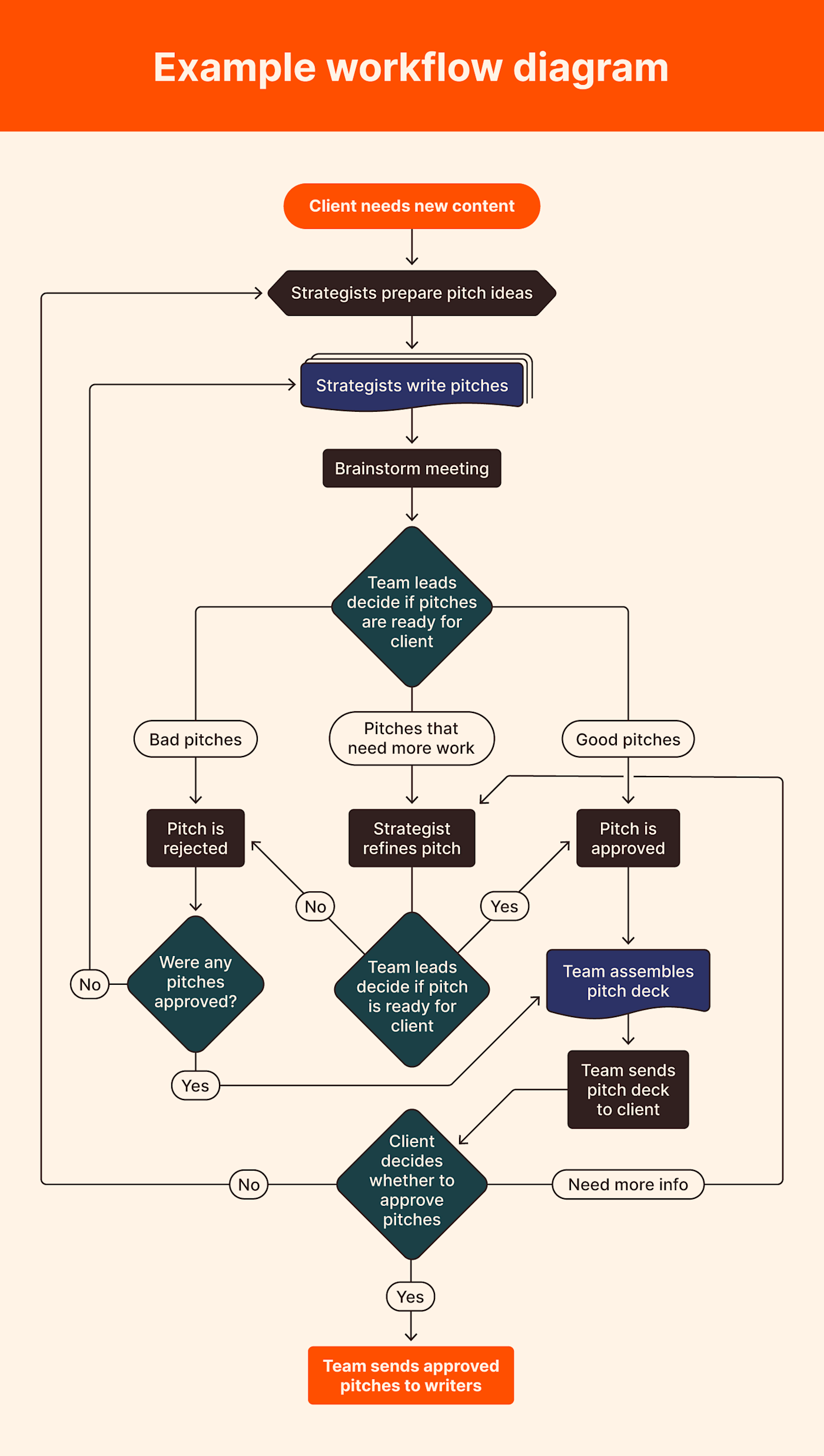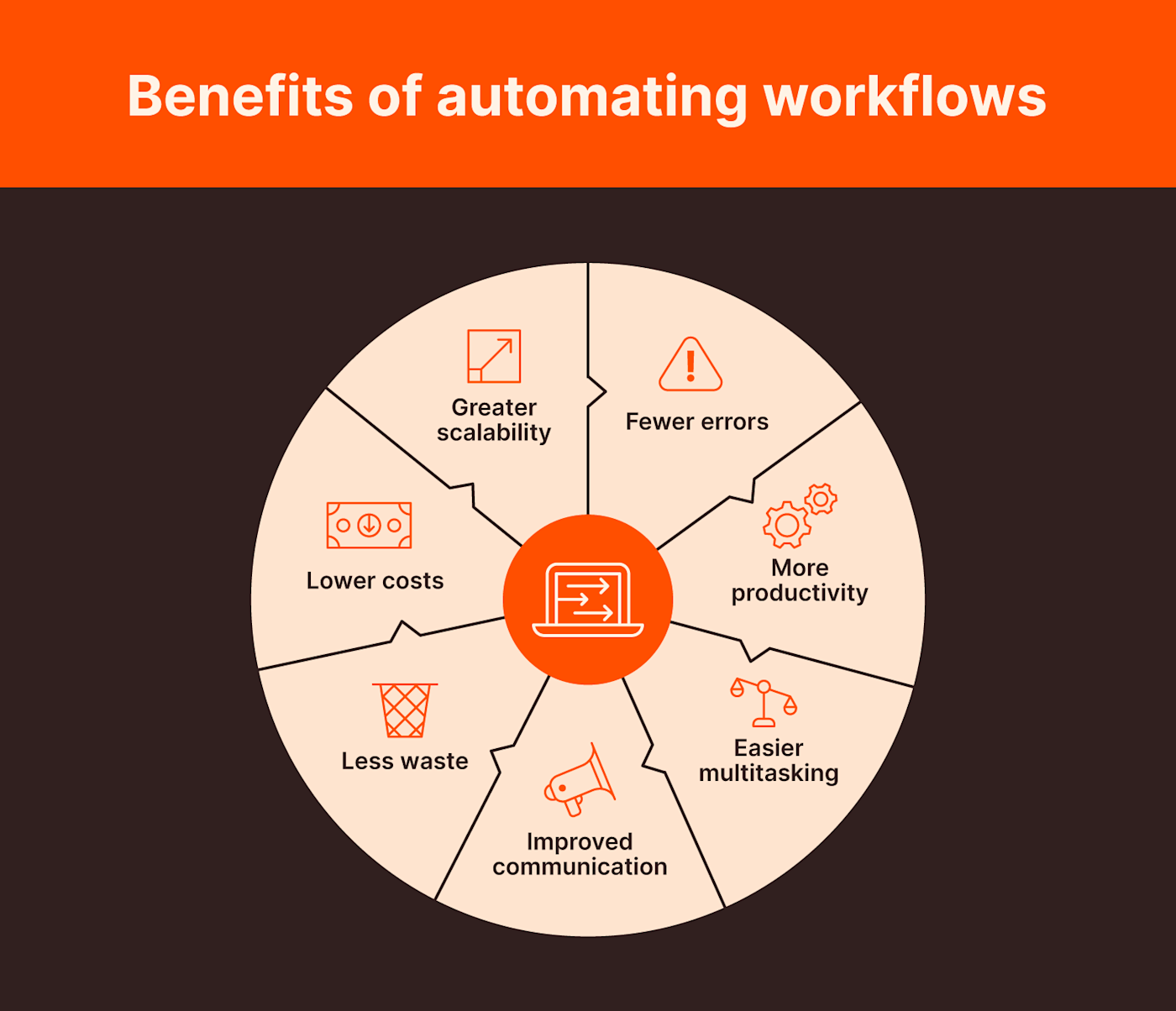I was 26 years old when I learned how to make rice. I thought you boiled it like pasta and then strained it in one of those super-tiny mesh strainers. I just filled my pot with reckless abandon—no gods, no masters, no measuring cups—until I moved in with my best friend, who was the first person comfortable enough to say: what in the world are you doing?
This is an excellent example of poor workflow management. Any process that includes a series of steps and is designed to be repeated falls under the definition of a workflow. Writing a blog post, filing a purchase order, and even making rice are all tasks that have workflows.
But not all processes are good workflows, which is where workflow management comes in. In the same way that I would have continued making soggy rice unless my best friend had intervened, most business workflows don’t work without the guidance of a skilled workflow manager.
Elements of a workflow
Since almost any multi-step process can be considered a workflow, there can be a lot of variation in what steps and parts are included. Workflows can be as simple as brushing your teeth or as complicated as a full warehouse fulfillment process. But all workflows have at least six key elements, no matter what type of process it is. They are:
-
Stakeholders: The individuals or groups that are affected by the workflow in some way. The stakeholders in a blog post workflow would be the writer, editor, and publisher. You’re the only stakeholder in a toothbrushing workflow, but in a family, the stakeholders are the kids doing the brushing and the parents checking to make sure the kids brushed.
-
Inputs: The materials or information that are required in order to complete the workflow. Inputs for a blog post would be the topic, research, and content; the inputs in a toothbrushing workflow would be a toothbrush, toothpaste, and floss.
-
Outputs: The results of the workflow—in our two examples, a published blog post and a set of clean teeth.
-
Steps: The individual tasks that need to be completed in order to complete the workflow. In the blog post workflow example, steps might include writing the content, editing the piece, and publishing it online. (I’m hoping you don’t need me to explain the steps for brushing your teeth.)
-
Transformation: The process of transforming the inputs into the outputs. A blog post undergoes transformation as the content is written, edited, and then published. Teeth are transformed from being un-brushed to sparkling clean.
-
Conditions: Conditions that need to be met in order for the workflow to be completed. If you’re a paid blogger, the conditions might be having a client who commissioned a post or having a blog pitch that was accepted by a publisher. Brushing your teeth can only happen under conditions like being near a bathroom and having your toothbrush on hand.
Visualizing workflows
Very simple workflows can be visualized as lists, but when processes become a little more complex, the best way to document them is in the form of a flowchart.
Flowcharts have a set of standard symbols that are used universally, which makes it easier to create workflows in a way that everyone will understand without needing each specific workflow explained in person. Especially when workflows have lots of decision points with different next steps for different answers, a standardized flowchart can work wonders for keeping massive workflows straight.
Here’s an example of the workflow my team uses to ideate and pitch blog post ideas to clients and publishers.

The workflow starts with the realization that the client needs new content, which triggers the pitch brainstorm process. Multiple strategists craft pitches individually, then team leads approve, reject, or request additional info about each pitch.
This is where things get complicated, workflow-wise—depending on what happens with the pitches, the workflow can go in one of three ways. Some of these paths loop back around as well—pitches that required more information get re-pitched and evaluated again. And depending on how many pitches are approved, the entire team may have to go back to square one to come up with a brand new set of ideas.
The workflow ends when enough pitches are approved for submission to the client and the client approves enough pitches to fill the editorial calendar for the coming month. Then, about three weeks later, the process starts over again.
Types of workflows
In addition to the six key elements that are consistent across workflows, all workflows can also be categorized into one of three types:
-
Sequential workflows. The type of workflow most people are familiar with is a sequential workflow, or a set of steps that need to be completed in order, one after the other.
-
State machine workflows. If you’re familiar with agile or Scrum workflows, then you’ll recognize that these are state machine workflows, or series of steps that need to be completed, but not necessarily in order. State machine workflows aren’t always completely orderless—often groups of tasks can be done in particular phases, but within those phases, the order of the steps is inconsequential.
-
Rules-driven workflows. The most complex type of workflow is the rules-driven workflow. These workflows have multiple potential orders, and the order in which they’re completed will vary depending on a set of rules. Because they’re so complex, they’re very difficult to set up and maintain by hand. But with an automation tool like Zapier, managers can turn workflow rules into “if this, then that” triggers that will implement the workflow correctly every single time.
What is workflow management?
Workflow management is the process of designing, creating, executing, and monitoring workflows. Obviously, not every workflow will have an official workflow manager, especially those that pertain to household and/or tooth-related tasks. But in a professional setting, workflow management is essential.
A workflow manager is the person who designs the workflow and gets the stakeholders set up to follow it. Typically, “workflow manager” isn’t an actual job title—it’s more of a descriptor for whoever is responsible for a particular process. For example, if you manage your company’s payroll processing workflow, you’re a workflow manager, but your actual job title is probably something related to your role in HR.
Workflow setup is just the beginning—the manager is also responsible for:
-
Setting and adjusting workflow steps
-
Troubleshooting dysfunctional workflows
-
Adjusting workflows to changing conditions
-
Creating and enforcing workflow documentation requirements
-
Keeping all stakeholders apprised and maintaining a standardized workflow communications system
-
Controlling access to workflows not suitable for open sharing
-
Generating and packaging workflow reports for use in larger business process management (BPM) operations
Workflow management vs. project management vs. business process management
One thing that frequently trips people up is the similarity between the terms “workflow management,” “project management,” and “business process management.” While the three things do overlap, they’re different in a few nuanced but important ways.
-
Workflow management deals with the supervision of individual processes. For example, the blog post pitch process I laid out above is a workflow, so the person who runs the brainstorm and facilitates the rest of the workflow for this round of pitches will be the workflow manager. Depending on who’s available, someone different may run the brainstorm process on the next round of pitches—in that case, that person will be the workflow manager.
-
Project management deals with the supervision of entire projects (groups of processes together). My team works with multiple clients at a time, and we create multiple pieces of content for each client every month. In a particular month, whoever is running the brainstorm is the brainstorm workflow manager, but the project manager is the person who oversees all the content being created for that client over the course of the entire contract. Some months, the project manager will run the brainstorm and function as the workflow manager as well, but the PM can also delegate the management of that particular workflow to someone else.
-
Business process management encompasses both workflow and project management. BPM is the umbrella term for all of a company’s processes and workflows, across different projects, teams, and departments. The pitch workflow and client project fall within the larger category of my company’s BPM, which also includes workflows and projects in the finance, human resources, and operations departments.
Workflow management software
Once you understand that workflows are the individual processes that make up a project, you should understand why there is no such thing as “workflow management software”: because project management software is already a thing.
Any software that allows users to manage a repeated process is, at least in part, workflow management software. The most obvious examples are platforms like Asana, Trello, and Smartsheet, which are designed specifically to manage projects and their associated processes and workflows.
Depending on what type of workflow you’re managing, though, you may find more effective workflow management tools in platforms designed for your specific project type. Salespeople often manage their workflows in Salesforce or Pipedrive, while accountants tend to use platforms like QuickBooks or Xero—you get the gist.
Workflow automation
One major benefit to using a platform to manage your processes is that it gives you the ability to automate workflows—and since workflows are repeatable by definition, they include a lot of automatable tasks. Many project management tools can be set up to independently handle tasks like:
-
Tracking metrics
-
Monitoring for errors
-
Notifying certain people when steps are completed or conditions are met
-
Storing and organizing documentation
-
Generating regular reports
If you use workflow automation software, like Zapier, that functions across multiple platforms, your automations can extend beyond your project management platform’s native automation tools. For example, your project manager can set up automatic in-app or email notifications from within a project management tool. But with cross-platform automation software, you can send those notifications to the tool your team actually uses for messaging, like Slack.

Zapier is an automation tool that connects your apps and moves information between them, so you can focus on what matters most. Check out this Zapier demo to learn more about how it works.
Workflow management best practices
Pretty much everyone in the world manages workflows every single day. What’s the point of “best practices” for a skill that most adults develop naturally?
Many of your day-to-day processes are workflows, but personal workflow management is about as related to professional workflow management as my driving record is to that of a career NASCAR driver. We’re doing the same thing, but not at the same level.
Professional workflow management is difficult, and it’s a skill that requires a lot of work and discipline to develop. Here are some tips that will make even the most complicated workflow management a little easier.
1. Document everything
And I mean everything. There’s nothing more frustrating than finding a problem, then digging into the causes only to find that the trail goes cold immediately because there are no notes, logs, or documents filed for that workflow. Ample documentation also helps prevent repeated mistakes.
For example, every pitch that my team generates includes the name of the person who wrote it, and every pitch, whether or not it’s approved, is filed away in an archive. This allows us to quickly search past pitches to make sure that an idea hasn’t been used or rejected already.
2. Do your best to predict failures and bottlenecks
No one can see the future (at least, as far as I’m aware), but workflow managers need to be able to find patterns and identify potential issues before they become full-fledged problems. This is another area where workflow automation comes in. In addition to alerting you when something is amiss, your workflow management system can also collect metric data and generate reports that will make it easier for you to notice sudden changes or concerning downtrends. This works in the opposite direction as well—with regular metric tracking, you can identify the reasons that things are going right and replicate them elsewhere in your workflow.
3. Create centralized workflow visuals
One of the things that makes workflows so valuable is that they act as a Single Source of Truth, providing a centralized place for all workflow-related information—they quite literally put everyone on the same page. Having a single centralized workflow helps eliminate miscommunication and prevent oversights that could otherwise lead to issues later on.
One of the simplest ways to visualize a workflow is with a flowchart. These apps are great for creating digital flowcharts and diagrams.
4. Collect feedback and audit regularly
We’ve already discussed why it’s useful to track metrics and generate regular reports. Don’t forget to also collect human feedback from your stakeholders and teams. Something that looks like a good idea on paper could be an absolute nightmare to execute, and unless you’re in regular contact with your stakeholders, you won’t know until it’s too late.
5. Minimize time spent on repetitive tasks
Workflow management is an extremely detail-oriented field, and even the most organized, most aggressively color-coded managers can’t handle it all without help taking care of the little things. Automate as many mini-tasks as possible, and use technology to set up safety nets that will catch details that you miss. Creating failsafes and automatic documentation records will not only save you time, but it will also give you peace of mind knowing that if you don’t catch something, your workflow management system will.
[adsanity_group align=’alignnone’ num_ads=1 num_columns=1 group_ids=’15192′]
Need Any Technology Assistance? Call Pursho @ 0731-6725516







